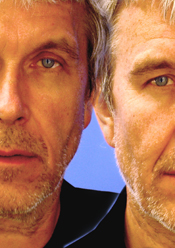Zbig was active in the avant-garde group Warsztat Formy Filmowej and he cooperated with Se-Ma-For Studios in Lodz, where his art movies were shot, including: Plamuz (1973), Zupa (1974), Nowa ksiazka (1975) and Tango (1980).
At the same time he also worked as a cinematographer on several feature films, including shorts by Andrzej Baranski, Piotr Andrejew and the acclaimed Dancing Hawk by Grzegorz Krolikiewicz.

Between 1977 and 1983 Rybczynski worked in Austria, where Weg Zum Nachbarn and Mein Fenster were made. He also set up a visual effects studio in Vienna for the Austrian TV. As the director of photography, co-writer and editor, he contributed to the cult horror feature Angst (also known as "Fear") directed by Gerald Kargl.
In the meantime, Zbig was involved in the Solidarity (Solidarnosc) movement in Poland. When martial law was declared, he received political asylum in Austria and it was there that he learned of his Academy Award for Best Animated Short Film nomination for Tango. After winning the Oscar for that film in 1983, Zbig and his family emigrated to the USA and settled in New York City. At his Manhattan and Hoboken studios, equipped with state-of-the-art High Definition Video, Rybczynski conceived and produced - as one of the first filmmaker - pioneer video films using HD technology.
In 1984 he was assigned by Lorne Michaels to create two short pieces The Discreet charm of Diplomacy and The Day Before (both produced by Alan Kleinberg) for NBC's "The New Show".
In Zbig Vision Studios Rybczynski produced his most important and acclaimed works: Steps 1987; The Fourth Dimension 1988 (produced by Robin O'Hara); The Orchestra 1990; and his favorite film Kafka in 1992.
Zbig is the creator of more than 30 outstanding music videos including John Lennon's Imagine and videos for artists such as Art of Noise, Mick Jagger, Pet Shop Boys, Chuck Mangione and Lou Reed. He was honored with three MTV Music Video Awards and the MTV Video Vanguard Award for his role as "a visionary in the field of music video". His work in film and video has also earned him numerous other awards such as three American Video Awards, three Monitor Awards for Best Director, the 1986 Billboard Music Video Award for Most Innovative Video, the 1986 BPI Video of the Year Award, as well as grand prizes at the Festivals at Annecy, France, in 1981, the Oberhausen Film Festival in both 1979 and 1981, and the Rio International Film Festival in 1987.
In 1990 Zbig won the Emmy Award for special effects in his film The Orchestra, a one-hour classical music HDTV program for PBS. It was the first Emmy ever given to a High Definition production. Later that year he was honored by the Japanese Ministry of Posts and Telecommunications for his outstanding work in advancing the uses of HD technology. In Italy he was awarded the Premio Internazionale Leonardo for his overall contribution to video, and in France - the Paris Cite for outstanding achievement in HD.
In 1992, Zbig completed work on the HD piece Kafka. Produced for Telemax of Paris as a part of their Audio/Visual Encyclopedia series, it won the 1992 Special Festival Prize at the International Electronic Cinema Festival Tokyo/Montreux and the Special Jury Award at the San Francisco International Festival in 1993.
In the years 1994-2001, Rybczynski worked in Germany. First, at the CBF Studios in Berlin, he was developing new production techniques in the areas of image compositing and motion control photography, holding several innovative patents in that area and in computer programs. Later, in Cologne, he continued his research and was a C-4 Professor of Experimental Film at the Academy of Media Arts.
In 2001 Zbig moved back to Los Angeles and until 2006 he worked on the development of image-related technologies for the Los Angeles based companies Ultimatte and iMatte.
In 2009, Zbig moved to Poland, taking up residence in Wroclaw, where he was head of the development and design of the state-of-the-art film studio for the production of special effects, multi-layer film images, and also an institute for education and research into images "The Audiovisual Technology Center" (CeTA). The opening took place in 2013 CeTA.
The whole project was financed by the Polish government. Unfortunately, Zbig discovered that the administrative team assigned to him by the authorities for project development was involved in embezzlement of public funds. After publicly revealing the corruption of state officials and after a year of unsuccessful attempts to fight the corrupt system, Zbig decided to return to the States.
In mid-2014, Zbig returned to the US and settled on a farm near Tucson, Arizona, where he and his wife, Dorota Zglobicka, are building a new,
high technology cinematography studio.